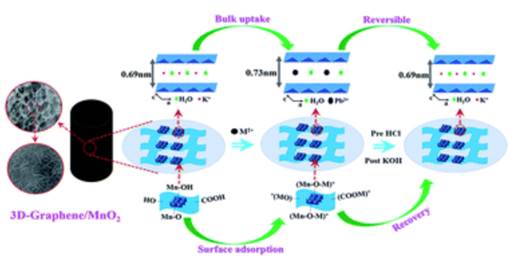


日前,记者从中科院合肥物质研究院获悉,该单位固体所环境与能源纳米材料中心在重金属污染物治理领域的研究取得重要进展,成功制备出了三维石墨烯/二氧化锰复合气凝胶材料,该材料对重金属有很好的去除性能。相关研究成果已发表在英国皇家化学会期刊《材料化学杂志A》上。
目前,治理重金属污染的方法有很多,其中吸附法因简单、高效、污染小等优点,被认为是最有前景的处理方法。但传统吸附剂材料都存在吸附量低、易团聚、极易产生二次污染、分离困难和循环性能差等瓶颈问题。
针对上述问题,该研究团队以石墨烯材料为原料,制备出三维石墨烯气凝胶材料,然后以该材料为模板沉积二氧化锰,制备出了三维石墨烯/二氧化锰复合气凝胶材料,其中二氧化锰呈薄片状,均匀分布在石墨烯的表面。所获得的复合气凝胶能高效去除污染水体中的Cu(II)、Cd(II)和Pb(II)离子等,其吸附动力学符合准二级模型。
据介绍,这种材料增强的吸附性能,主要来源于三维石墨烯/二氧化锰复合气凝胶中大量的含氧官能团对重金属离子的络合,以及层状二氧化锰与重金属离子的离子交换作用。此外,该气凝胶材料还具有良好的循环稳定性,经过8次的吸—脱附实验后,其吸附效率仍可达到初始吸附容量的98%。因此,三维石墨烯/二氧化锰复合气凝胶材料的设计合成为重金属污染物的治理提供了崭新的思路和技术支撑。(来源:中国科学报 李瑜)
3D graphene/δ-MnO2 aerogels for highly efficient and reversible removal of heavy metal ions
Abstract Novel three-dimensional (3D) graphene/δ-MnO2 aerogels were fabricated via self-assembly and reduction of graphene oxide, followed by in situ solution-phase deposition of ultrathin δ-MnO2 nanosheets. The resultant graphene/δ-MnO2 architectures showed an interconnected 3D network microstructure, in which a large number of ultrathin birnessite MnO2 nanosheets were homogenously deposited on the graphene framework. Due to their unique structural characteristics, the resulting 3D aerogels exhibited a fast adsorption kinetic rate and superior adsorption capacity toward heavy metal ions. The saturated adsorption capacities of graphene/δ-MnO2 aerogels were as large as 643.62 mg g−1 for Pb2+, 250.31 mg g−1 for Cd2+ and 228.46 mg g−1 for Cu2+ calculated by the Langmuir isotherm model, exceeding largely the corresponding pristine 3D graphene and δ-MnO2 nanosheets. It was noted that the heavy metal ions could not only adsorb on the surface of graphene/δ-MnO2, but also intercalate into the interlayer gaps of birnessite MnO2, which reveals the synergistic effect of the static electrical attraction, surface complexation and ion exchange between heavy metal ions and pre-intercalated K+, supported by the expansion of the basic crystal structure of layered MnO2 after adsorption. Furthermore, it is interesting that the regenerated aerogels after the initial HCl and subsequent KOH treatment still maintain their original shape and can be repeatedly used for more than eight cycles without obvious degradation of performance, which achieved the sustainability of the absorbents. More importantly, the hybrid aerogels can be easily separated and do not generate secondary contaminants. High removal efficiency, fast adsorption kinetics, excellent regeneration and reusability, and ease of separation operation make these hybrid aerogels ideal candidates for heavy metal ion decontamination in practical application.
原文链接:http://pubs.rsc.org/en/content/articlepdf/2016/ta/c5ta08106h



